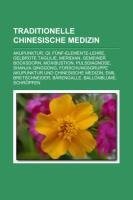
-
 Nemecký jazyk
Nemecký jazyk
Traditionelle Chinesische Medizin
Autor: Quelle: Wikipedia
Quelle: Wikipedia. Seiten: 200. Nicht dargestellt. Kapitel: Akupunktur, Qì, Fünf-Elemente-Lehre, Gelbrote Taglilie, Meridian, Gemeiner Bocksdorn, Moxibustion, Pulsdiagnose, Shanjia Qinggong, Forschungsgruppe Akupunktur Und Chinesische Medizin, Emil Bretschneider,... Viac o knihe
Na objednávku, dodanie 2-4 týždne
36.72 €
bežná cena: 40.80 €
O knihe
Quelle: Wikipedia. Seiten: 200. Nicht dargestellt. Kapitel: Akupunktur, Qì, Fünf-Elemente-Lehre, Gelbrote Taglilie, Meridian, Gemeiner Bocksdorn, Moxibustion, Pulsdiagnose, Shanjia Qinggong, Forschungsgruppe Akupunktur Und Chinesische Medizin, Emil Bretschneider, Bärengalle, Ballonblume, Schröpfen, Qigongkugeln, Ernährung Nach Den 5 Elementen, Zhi Gang Sha, Tuina, Wushi'er Bingfang, Qi Bo, Yoshimasu-Formel, Banlangen, Chinawachs, Nin Jiom Pei Pa Koa, Shiliao Bencao, Christel Heidemann, Yinshan Zhengyao, Mantak Chia, Organuhr, Bagang, Drachenknochen, Zhenggu, Bafa, Jing, Hulu, Zungendiagnostik, Tabaxir, Buchreihe Von Historischen Chinesischen Werken Zur Chinesischen Ess- Und Trinkkultur Sowie Diätetik, World Federation of Acupuncture-Moxibustion Societies, Dantian, Wuwei Handai Yijian, Chinesische Akademie Für Traditionelle Chinesische Medizin, Cun, Faqi, Ynsa. Auszug: In traditional Chinese culture, qi (simplified Chinese: ; traditional Chinese: ; Mandarin Pinyin: qì; Wade-Giles: ch'i; Jyutping: hei; pronounced in English; in Standard Mandarin; Korean: gi; Japanese: ki; Vietnamese: khí, pronounced ) is an active principle forming part of any living thing. It is frequently translated as "energy flow," and is often compared to Western notions of energeia or élan vital (vitalism) as well as the yogic notion of prana. The literal translation is "air," "breath," or "gas" (compare the original meaning of Latin spiritus "breathing"; or the Common Greek p¿e¿µa, meaning "air," "breath," or "spirit"; and the Sanskrit term prana, "breath"). The etymological explanation for the form of the qi logogram in the traditional form ¿ is "steam (¿) rising from rice (¿) as it cooks". The earliest way of writing qi consisted of three wavy lines, used to represent one's breath seen on a cold day. A later version, ¿, (identical to the present-day simplified character) is a stylized version of those same three lines. For some reason, early writers of Chinese found it desirable to substitute for ¿ a cognate character that originally meant to feed other people in a social context such as providing food for guests. Appropriately, that character combined the three-line qi character with the character for rice. So ¿ plus ¿ formed ¿, and that is the traditional character still used today. (See the Oracle bone character, the Seal script character and the modern "school standard" or Kai shu characters in the box at the right for three stages of the evolution of this character.) Kanji used in Japan for "ki" until 1946, when it was changed to . Koreans maintain the older character in their "hanja".In the Japanese language, the Chinese character corresponding to qi (¿) is pronounced ki. The Japanese language contains over 11,442 known usages of "ki" as a compound. As a compound, it may represent syllables associated with the mind, the heart, feeling, the atmosphere
- Vydavateľstvo: Books LLC, Reference Series
- Rok vydania: 2016
- Formát: Paperback
- Rozmer: 228 x 154 mm
- Jazyk: Nemecký jazyk
- ISBN: 9781159333201



 Anglický jazyk
Anglický jazyk 






 Španielsky jazyk
Španielsky jazyk 

